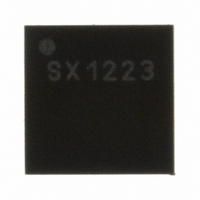SX1223I073TRT Semtech, SX1223I073TRT Datasheet - Page 13

SX1223I073TRT
Manufacturer Part Number
SX1223I073TRT
Description
IC TX UHF 433/868/916 MHZ 24TQFN
Manufacturer
Semtech
Datasheet
1.SX1223SK433.pdf
(25 pages)
Specifications of SX1223I073TRT
Frequency
425 ~ 475MHz / 850 ~ 950MHz
Applications
AMR, Home Automation, HQ Music and Data
Modulation Or Protocol
FSK
Data Rate - Maximum
153.6 kbps
Power - Output
10dBm
Current - Transmitting
25.8mA
Data Interface
PCB, Surface Mount
Antenna Connector
PCB, Surface Mount
Voltage - Supply
2 V ~ 3.6 V
Operating Temperature
-40°C ~ 85°C
Package / Case
24-TQFN
Lead Free Status / RoHS Status
Lead free / RoHS Compliant
Features
-
Memory Size
-
Other names
SX1223I073TR
4.2.5
4.2.6
4.2.7
4.2.8
From equation (4.4), it can be seen that VCO is proportional to carrier frequency. MOD_I is the best parameter to
alter to counteract this effect if necessary.
Combining equations (4.2), (4.3), and (4.4) gives an expression for the frequency deviation:
The modulation waveform will be shaped due to the charging and discharging of a capacitor. The waveform looks
like a Gaussian filtered signal with a Bandwidth Period-product (BT) given by:
It can be seen from this equation that a low BRn gives a low shaping factor.
In addition to this, it is possible to smooth the modulator output in a programmable low-pass filter. This filter is
controlled by the parameter MOD_F. The parameter should be set according to equation (4.7).
The modulator output voltage is generated with a capacitor that is being charged. This means that there is a risk of
saturating the modulator if the charge received by the capacitor is too large. The maximum value of MOD_I can be
determined by using equation (4.8).
If it turns out that the MOD_I-range is too small for the application, the solution can be found by increasing BRn and
decreasing RefClk_K accordingly.
The necessary equations needed for the use of the modulator are (4.1), (4.5), (4.6), (4.7), and (4.8). The table
below gives a summary of the meaning of the parameters.
In MW3 the modulation is done by switching between two frequency divider ratio sets: M
The frequency f
transmission of the two possible values ‘0’ and ‘1’.
© Semtech 2007
Symbol
RefClk_K
BRn
MOD_F
MOD_I
MOD_A
Shaping for MW1 and MW2
Modulator Saturation for MW1 and MW2
Summary of Modulator Settings for MW1 and MW2
Frequency deviation setting for MW3
BT
MOD
MOD
f
_
RefClk_K
2
I
_
f
0
BRn
F
XTAL
Range
(inclusive)
1..63
0..5
0..3
1..31
0..4
will be generated using the first set and frequency f
Re
150
f
fClk
XTAL
2
BR
MOD
_
MOD
K
10
3
28
_
_
Explanation
The crystal oscillator frequency is divided by this number to produce the modulator
clock, and it is divided further down by 8 to produce bit rate clock.
Number of extra divide-by-two for the bit rate clock.
Programmable smoothing filter after attenuator. This can be programmed in four
steps, and will produce reasonable results for the highest bit rates.
Frequency deviation. The deviation is linearly dependent on this variable.
Frequency deviation attenuator (or range selector). The attenuations are (values 0
through 4, respectively)
I
A
10
Const
6
1
1
Const
Table 5: Modulator settings
2
2
FreqBand
f
C
2
1
13
1
FreqBand
,
1
2
,
1
4
1
,
using the second set, corresponding to the
1
8
, and
1
16
.
(4.5)
(4.6)
(4.7)
(4.8)
0
, N
0
, A
0
www.semtech.com
and M
SX1223
1
, N
1
, A
1
.












